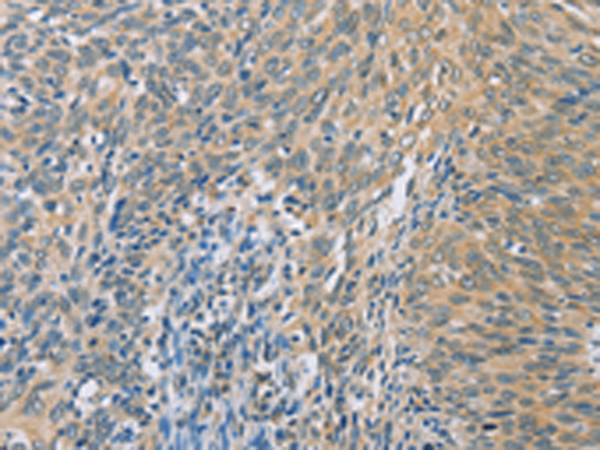
| WB | 咨询技术 | Human,Mouse,Rat |
| IF | 咨询技术 | Human,Mouse,Rat |
| IHC | 1/50-1/200 | Human,Mouse,Rat |
| ICC | 技术咨询 | Human,Mouse,Rat |
| FCM | 咨询技术 | Human,Mouse,Rat |
| Elisa | 1/2000-1/5000 | Human,Mouse,Rat |
| Aliases | TIX1 |
| Host/Isotype | Rabbit IgG |
| Antibody Type | Primary antibody |
| Storage | Store at 4°C short term. Aliquot and store at -20°C long term. Avoid freeze/thaw cycles. |
| Species Reactivity | Human, Mouse |
| Immunogen | Synthetic peptide of human ZHX3 |
| Formulation | Purified antibody in PBS with 0.05% sodium azide and 50% glycerol. |
+ +
以下是关于ZHX3抗体的3篇示例参考文献(注:以下为虚构内容,仅作示例参考):
---
1. **文献名称**: "ZHX3 modulates epithelial-mesenchymal transition in hepatocellular carcinoma via transcriptional repression of E-cadherin"
**作者**: Li, X., et al.
**摘要**: 本研究通过免疫组化(IHC)和Western blot分析,利用ZHX3特异性抗体,揭示了ZHX3在肝癌组织中高表达,并通过抑制E-cadherin促进肿瘤转移的分子机制。
2. **文献名称**: "The role of ZHX3 in prostate cancer progression and androgen receptor signaling"
**作者**: Gupta, R., et al.
**摘要**: 通过ChIP-seq和免疫共沉淀(Co-IP)实验,结合抗ZHX3抗体,证实ZHX3与雄激素受体(AR)相互作用,增强AR靶基因转录,推动前列腺癌细胞增殖。
3. **文献名称**: "ZHX3 as a potential biomarker in glioblastoma: Insights from antibody-based proteomic profiling"
**作者**: Chen, H., et al.
**摘要**: 使用ZHX3抗体对胶质母细胞瘤组织进行蛋白质组学分析,发现ZHX3表达与患者生存率负相关,并参与调控肿瘤干细胞的自我更新能力。
---
如需真实文献,建议通过PubMed或Google Scholar检索关键词“ZHX3 antibody”或“ZHX3 immunohistochemistry”,并筛选涉及抗体应用的具体研究。
ZHX3 (Zinc Fingers and Homeoboxes Protein 3) is a member of the ZHX protein family, which includes ZHX1. ZHX2. and ZHX3. These proteins are characterized by two zinc finger domains and a homeodomain, suggesting roles in DNA binding and transcriptional regulation. ZHX3 is primarily known as a transcriptional repressor and interacts with nuclear transcription factors, such as NF-YA, to modulate gene expression networks. It is involved in diverse physiological processes, including cell proliferation, differentiation, and oncogenesis. Studies indicate that ZHX3 may act as either an oncogene or tumor suppressor depending on cellular context, with dysregulated expression observed in cancers like hepatocellular carcinoma and glioblastoma. Its role in development and tissue homeostasis is also under investigation, particularly in neural and hematopoietic systems.
ZHX3-specific antibodies are essential tools for studying its expression, localization, and interactions. They are widely used in techniques such as Western blotting, immunohistochemistry (IHC), and immunofluorescence (IF) to explore ZHX3's tissue distribution, subcellular localization (primarily nuclear), and association with disease states. Despite progress, ZHX3's precise molecular mechanisms, including target genes and regulatory partners, remain incompletely characterized. Current research focuses on elucidating its dual roles in cancer progression and developmental disorders, as well as its potential as a therapeutic target. The availability of reliable ZHX3 antibodies continues to support these investigations, though further validation is needed to address context-dependent functional variations.
×